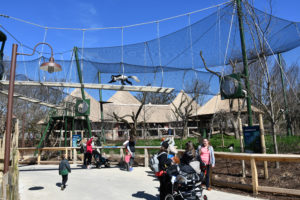Since 1969, the Louisville Zoo has continuously grown and evolved thanks to you — our generous supporters. Louisville Zoo donors have helped us accomplish remarkable projects that provide amazing guest experiences and care for the animals, while shaping the future of zoos around the world.

Keepers shift a tiger through the passageways of the rotational Islands exhibit.
One stellar example is the Islands exhibit complex, home to orangutans, Sumatran tigers, siamangs, babirusa pigs and Malayan tapirs. Opened in 1997, Islands was the world’s first multi-species rotational exhibit. It shifted the paradigm of Zoo exhibit design and put Louisville Zoo in an esteemed position amongst Zoo professionals worldwide.
Essentially, the Islands was a game changer: it introduced an abundance of new daily choices for a variety of Islands animals (predator and prey) through a complex of passageways leading to a series of connected naturalistic habitats — challenging the traditional one animal in one exhibit space, all day long model. The design also eliminated bars between guests and animals, creating opportunities for nose-to-nose encounters through glass. To utilize the passageways, the development of new animal management techniques was required to help move animals from space to space, safely — techniques shared now across the zoo universe.
Louisville Zoo staff imagined and engineered a remarkable scenario where both guests and animals were enriched by new experiences. The Islands was born from invention, persistence, ingenuity and the generosity of donors in our community. Since its opening, numerous zoo professionals have visited Islands to observe and study the rotational exhibit design model. If you visit other zoos like Tacoma Zoo, Philadelphia Zoo and Jacksonville Zoo, you are likely to see added variations on the rotational exhibit model inspired by your Zoo.

Colobus monkeys explore extended passageways in the new rotational Colobus Crossing exhibit.
Our team in Louisville advanced the rotational exhibit model in two additional award-winning exhibits: Gorilla Forest (opened in 2003) and Glacier Run (opened in 2012). This spring, we opened Snow Leopard Pass and Colobus Crossing, both of which feature the rotational system with next-generation advancements including extended passageways with training platforms that now allow animals additional areas to explore outside of the primary exhibit spaces — specifically, over the heads of guests.
The commitment of advocates, community leaders, philanthropists and of course, children and adults who love nature and animals, helped create our Zoo 50 years ago. That formula still holds true today and sustains our wonderful Zoo. Thank you for always being there. We simply could not do it without you and look forward to partnering with you for many years to come.

